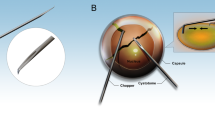Summary
The endothelial cell count after phacoemulsification serves as a sensitive indicator for the level of corneal traumatization caused by different phacoemulsification techniques concerning the used phacotime and phacoenergy/s.
Patients: In a prospective and randomized study, the “reversed tip and snip” technique and the “divide and conquer” technique were performed in groups of 30 patients each. The corneal endothelial cell count was measured preoperatively as well as 4 weeks and 3 months postoperatively. In a second study the phacotime and phacoenergy used/second and the endothelial cell loss were compared between patients 1–30 and 31–60 who were operated on with the “reversed tip and snip” technique, demonstrating the learning curve of this technique.
Results: The endothelial cell count showed significant (P < 0.001) reduction by about 10 % after the “reversed tip and snip” technique and by about 15 % after the “divide and conquer” technique. The latter produced significantly greater cell loss. The phacotime (mean: 22–17) and phacoenergy/s (mean: 23–16) were reduced significantly (P < 0.05) when patients 1–30 were compared with 31–60.
Conclusion: The “reversed tip and snip” phacoemulsification technique produces less endothelial cell loss than the “divide and conquer” technique. There is a short learning curve by using the “reversed tip and snip” technique.
Zusammenfassung
Hintergrund: Der Hornhautendothelzellverlust, die Phakozeit wie auch die Phakoenergie/s sind empfindliche Parameter zum Vergleich unterschiedlicher Phakotechniken.
Patienten und Methode: In einer prospektiven Studie über 3 Monate werden jeweils 30 Patienten mit der „Reversed Tip and Snip“- sowie mit der „Divide and Conquer“-Technik operiert. Die Hornhautendothelzelldichte wird präoperativ und 4 Wochen und 3 Monate postoperativ im Hornhautzentrum gemessen. In einer weiteren Studie werden konsekutiv mit der Reversed Tip and Snip-Technik 30 Patienten operiert und die zentrale Endotheldichte, die Op-Dauer, die Phakozeit und die Phakoenergie/s zwischen den Patienten der ersten und der zweiten Untersuchung verglichen.
Ergebnisse: Postoperativ ist die Endothelzellzahl bei der „Reversed Tip and Snip“-Technik im Zentrum signifikant um 10 % reduziert. Der Verlust bei der „Divide and Conquer“-Technik beträgt im Zentrum 15 %. Im Vergleich beider Techniken zeigt erstgenannte Technik einen signifikant (p < 0,01) geringeren Zellverlust im Hornhautzentrum. Der Endothelzellverlust sowie die Phakozeit konnten bei den Patienten 31–60 signifikant (p < 0,01) reduziert werden.
Schlußfolgerung: Die „Reversed Tip and Snip“-Technik ist im Vergleich zur „Divide and Conquer“-Technik ein endothelschonenderes Verfahren. Sie erfordert einen gewissen, aber raschen Lernprozeß.
Similar content being viewed by others
Author information
Authors and Affiliations
Rights and permissions
About this article
Cite this article
Kohlhaas, M., Walter, A. “Reversed tip and snip” phacoemulsification. Ophthalmologe 95, 478–481 (1998). https://doi.org/10.1007/s003470050300
Published:
Issue Date:
DOI: https://doi.org/10.1007/s003470050300




